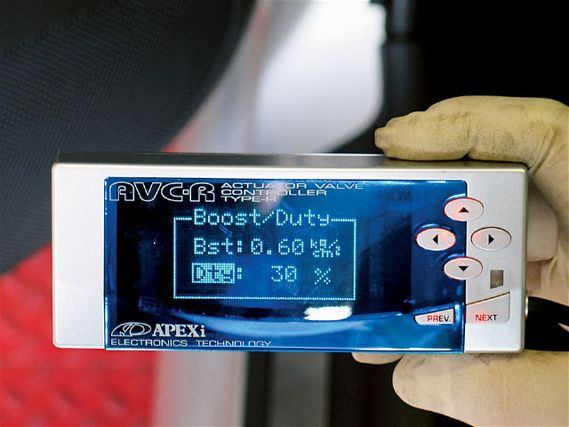 | Project Mazdaspeed Protege Boost Up - Dyno Cell MSP Boost-up
| Project Mazdaspeed Protege Boost Up - Dyno Cell MSP Boost-up Boost controllers carry with them the promise of instant gratification. Twist a knob or scroll a cursor and you'll make more boost and more power. As in most things in life, moderation is key. When turning up the boost, it's sinful not to have some sort of air/fuel ratio monitoring device hooked up. Each engine will react differently to added boost levels; the traditional limitations are the stock fuel system, size of the turbo and flow capability of the head(s). The fuel system is the biggie.
Going into the Turbo magazine Dyno Cell to pump up the boost on our Mazdaspeed Proteg, we knew there would be a boost cut at around 10 psi and we had a trusty HKS Fuel Cut Defenser at the ready to trick the ECU into allowing more boost.
We got the party started by wiring up the AVC-R, which does more than regulate the turbo's wastegate. The AVC-R has a monitor feature that uses the vacuum fluorescent display to provide real-time information regarding boost pressure, engine speed, vehicle speed, throttle position, solenoid duty cycle and injector duty cycle. One, two, three, or four of these parameters can be displayed and most of the parameters can also be viewed in numeric, analog-gauge (meter) or graph-style displays. The monitor functions can be set up as peak/hold-style readouts and limited data logging is possible with the AVC-R.
For most applications, the AVC-R pressure sensor is tapped in between the O.E. pressure regulator and the intake manifold while the AVC-R boost solenoid is positioned between the wastegate actuator and intake system. Wiring up the system on the Proteg meant getting some key ECU pin-out information from iON Performance. Finding an rpm source was also a bit tricky, but we managed. Getting the wiring correct is important to ensure that unit is able to monitor all the expected parameters. Even more importantly, since the unit uses a fuzzy logic function to "learn" the boost habits of the engine, the AVC-R needs to know things like engine speed, throttle position in percentage, etc. to function properly. The AVC-R can also dish out the boost based on engine rpm, by gear or as a general target boost controller.
Maximum boost pressure is programmed in the Setting menu by highlighting the Boost [shown as "Bst:"] line and scrolling up or down. The unit measures boost in kg/cm2. Once a boost level is selected, the AVC-R will learn the duty cycle. The duty cycle is how fast the controller responds. A typical wastegate will begin to open and bleed boost well before realizing its set maximum pressure. Duty cycle allows the wastegate to stay closed much longer, which enhances mid-range power and speeds the responsiveness of the turbo system.
In the Dyno Cell it was time to generate some power. With the AVC-R set to .50 kg/cm2 (7.36 psi) the MSP's 2.0-liter DOHC powerplant belted out 191.0 whp and 175.7 lb-ft of torque. With the max boost set at .60 kg/cm2 (8.82 psi) the Mazda pumped out 210.2 whp and 187.9 lb-ft of grunt. Rolling along, we upped the ante to .70 (10.29 psi) and were surprised to miss the OE fuel cut off. Power checked in at 219.3 and torque was 196.8 lb-ft. The engine pinged its displeasure and a retest reaffirmed there was detonation at the top end. Looking at the air/fuel chart, we realized the engine was "leaning" out at about 6000 to 6200-if you call 11.1:1 lean. The ratio went off the chart (rich) as usual at 4200 to 4500 rpm and we had hoped to see it come back to a more power-friendly ratio with more boost. Not only did this not happen until the end of the run, but the engine didn't like it at all.
We were at a crossroads. To get more out of the Mazdaspeed Proteg, we'd have to install a high-flow fuel pump or do a ROM tune, or both to taper the air/fuel ratio. Unichip makes a neat piggyback computer that can address fueling and timing; this is the way we'd suggest going. Unfortunately, Mazda doesn't want us "running wild" with the car, and we're almost at the end of the loan period. So we'll call it a day... well, almost.
Reviewing the chart, we could see everything was cool until the ratio popped up at 6000 rpm. So we elected to bump the boost to .80 (11.76 psi) and stop sampling at 6000 rpm. And boy, were we stomping on the terra until the ECU fuel cut dropped a stink bomb on the session. At 5100 rpm, we were already at 225 whp and still on the march. Extrapolating the curve we were on a 242-whp run, all other factors remaining consistent.
We set the boost to .70 (10.29 psi) and hit the highway. The car was a monster and the iON turbo back exhaust was really paying off as the turbo spooled quickly and was able to keep the boost flowing, thanks to reduced restriction on the hot side. Enthusiasts, not constrained by a loan agreement, could be running 14 to 15 psi-and they must be in heaven. We have come a long way with the Mazdaspeed Proteg and illustrated how every car/engine has its own quirks. We will miss the challenges the feisty car presents and the rewards it delivers when you jump on the loud pedal.
